 Review Article
Review Article
A Dynamic Example for Explaining the Tradition of Storage and Stamp in Primary Societies: Based on Ethno-Archeological Studies in the Makhunik Village
Tahereh Rahimkhani1* and Hadi Sabori Kanik2
1Department of Archaeology, University of Birjand, Iran
2Department of Archaeology, Art University of Isfahan, Iran
Tahereh Rahimkhani, Department of Archaeology, University of Birjand, Iran.
Received Date: February 04, 2019; Published Date: March 29, 2019
Summary
The system of storage and resource management is one of the main features of the early societies in dealing with internal and external factors. Given the small archaeological evidence of the early societies, the mechanism of this system is not clear to us. Ethnographic studies are one of the most practical ways to clarify such issues. The Kanik structure in the Makhunik village is a dynamic example of such spaces. The Makhunik village is a documented and reliable repository for analyzing and interpreting such topics because of a similar cultural background to prehistoric periods such as architecture, subsistence and pottery. In this paper, we have tried to study and analyze the approach of experimental studies in the cultural-historical context of Makhunik with different angles of the Kanik structures and its functions in order to explain and understand more about the storage management system in the early societies.
Keywords: Ethnoarcheology; Iran; Makhunik village; Early society; Storage; Management system
Natural and Cultural Landscape
Makhunik is one of the villages of southern Khorasan Province in eastern Iran (Figure1). The village is located at 60° 24’east longitude and 32° 27’ north latitude and a height of 1650 meters [1,2]. This settlement is located in the mountainous and rugged wildlife, for this reason, has been restricted with peripheral communities, as well as access to natural resources from fertile soil and water [3].
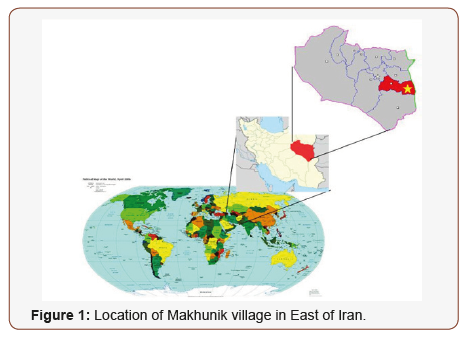
The main feature of Makhunik is the different architecture of the traditional texture in this village [4]. An important feature of Makhunik village are architectural structures comparable to prehistoric sites. These features include small dimensions of structures, components and materials used (doors are 30 × 50 cm and houses are 3 × 4 meters) (Figure 2).
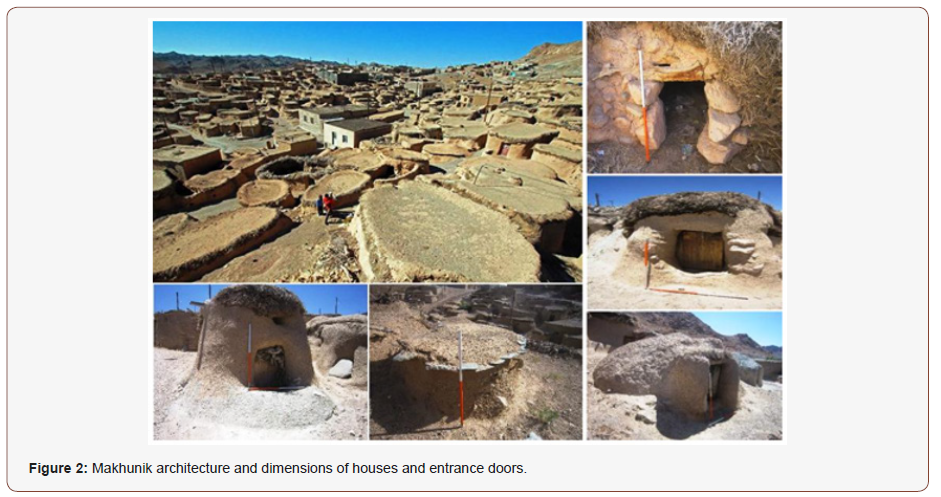
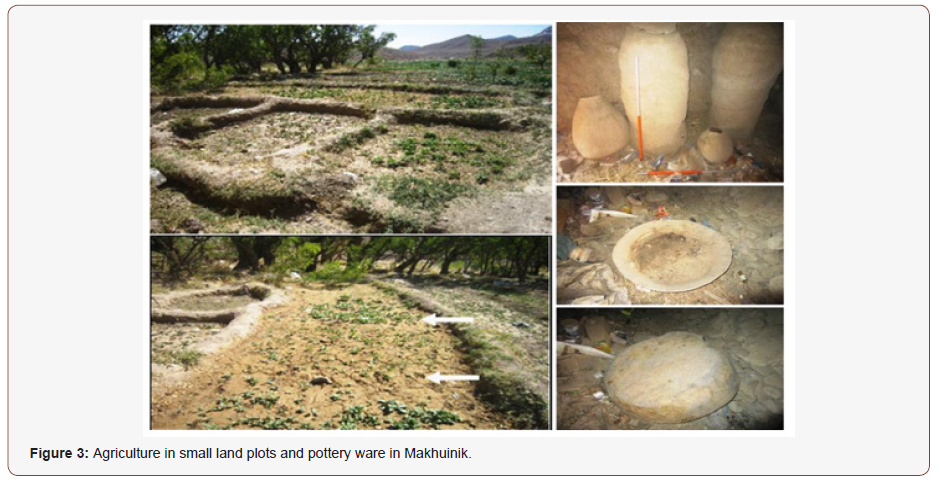
The subsistence economy of the village inhabitants relies on very small parts of agricultural land(1 × 1 meter) that is meaningful compared to limited architectural spaces. The pottery samples used in this village are in form and type quite similar to those obtained from prehistoric periods. The Kaniks’ structure is also a special Makhunik cultural element that will be further discussed. (Figure 3).
Kanik Structure, Description and Analysis
Kanik is a structure of natural holes in the granite rocks in the distance 3 km west of Makhunik village (Figure 4). Given the ecosystem limitations and Possible risks, these spaces are used for food storage (Often, beetroots are called “Pokhtik” in the local term), resource management and Maintenance of documents (Marriage certificates, land documents etc). These spaces have been used in dialogue with the elders and local information from past ages and have continued to be hereditary to this day.
These cavities are located at an approximate height of 20 meters from the ground, which makes it difficult for non-indigenous people to access it. Due to the natural size of the gaps, Kandiks are visible in irregular sizes and shapes. Their interior space is not large and according to natural conditions of cavities, food and documents are placed there. Each of these (Kaniks) is unique to a family that inherited from their ancestors. Large holes are divided into smaller parts by using stone materials and are covered with mud (Figure 5).
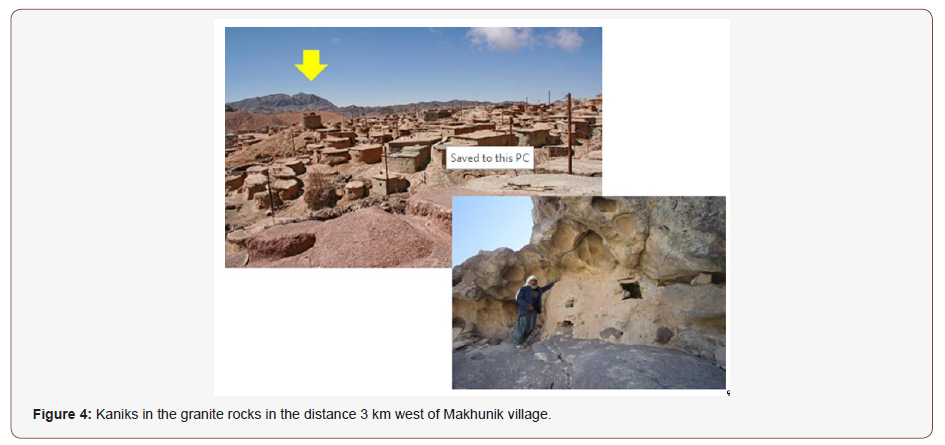

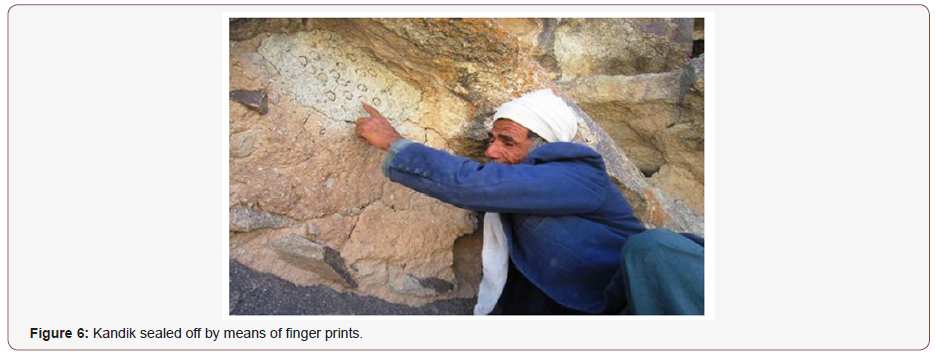
The access points are very small and limited and can only be used for the placement and transfer of items and documents using the hand. Eventually, these holes were sealed using muds and It was distinguished from other examples (private property) by signs that were pressed with a finger on the mud (Figure 6). It should also be noted that Kaniks are guarded and protected by the villagers take turns.
Conclusion
Based on existing evidence and ethnographic information from Makhunik, it seems that the ecosystem restrictions have the same texture as a prehistoric settlement. The same factor has caused the Makhunik village to have a a lot of consistency of cultural characteristics of the prehistoric period. Kandik, as a storage management structure, can be generalized to the Makhunik cultural context in relation to the resource storage system in the early societies, so that all of the existing cultural elements, such as architecture, subsistence, pottery technology, etc., can be interpreted in relationship to this management structure.
Acknowledgement
Thank you so much of all the people of Makhunik village, especially the honorable family of Mr. Rahnama and Mahmoud Makhuniki for their helps.
Conflict of Interest
No Conflict of Interest.
References
- Yousefi M, Astani S (2010) A survey of traditional attitudes and cultural diversity in one of the most amazing rural areas (Case study of Makhunik Village, Iran’s Lili Puts Village) National Conference on Biodiversity and Indigenous Knowledge (In Persian).
- Brabadi SA, Shoaibi GH (2005) Makhuniks Anthropology. Tehran: Cultural Heritage and Tourism Organization. Archaeological Research Center (In Persian).
- Golmohamadi F (1390) Study of Education Methods and Promotion of Indigenous Knowledge of Rural Architecture (Case Study of Sistan and Baluchistan Province), Housing and Village Environment journal (In Persian) 136: 94-79.
- Rahimkhani T (2015) Ancient Architecture Makhunik. Master’s thesis in archeology. Birjand University, Iran.
-
Tahereh Rahimkhani, Hadi Sabori Kanik. A Dynamic Example for Explaining the Tradition of Storage and Stamp in Primary Societies: Based on Ethno-Archeological Studies in the Makhunik Village. Open Access J Arch & Anthropol. 1(3): 2019. OAJAA.MS.ID.000511.
-
Ethnoarchaeology, Iran, Makhunik village, Early society, Storage, Management system
-

This work is licensed under a Creative Commons Attribution-NonCommercial 4.0 International License.






